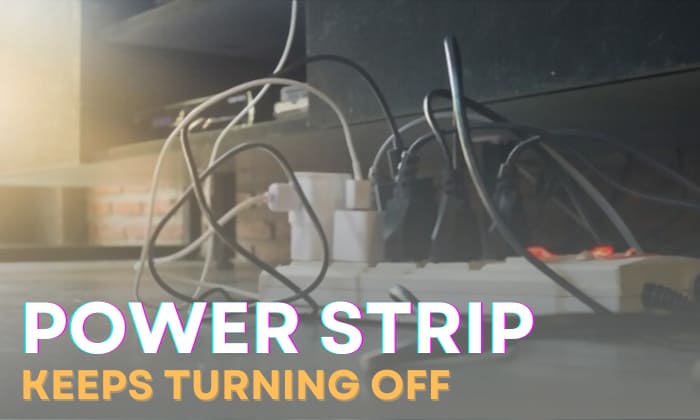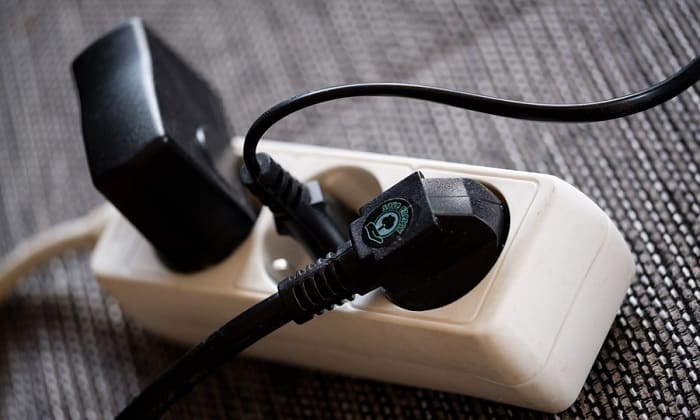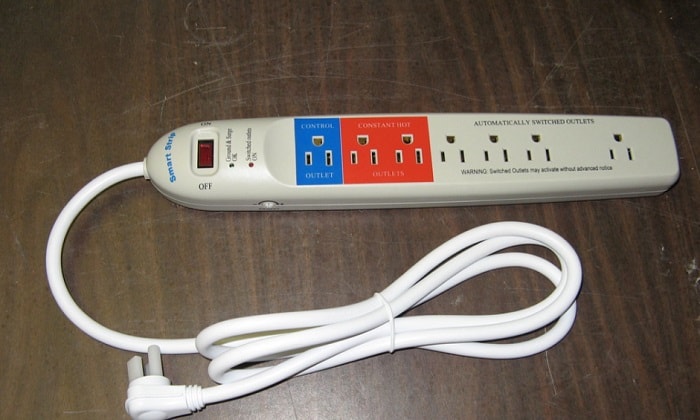I’ve had various people, from coffee-loving millenials and seniors to gamers and PC builders, approach me over the years asking me why their power strip keeps turning off. If you’re having the same problem, you’ll want to look at three main things.
- It’s overloading because of how you’re using it (e.g. connecting it to multiple power strips or using numerous appliances at once) or because of electrical surges or low voltage.
- You’re pairing it with an incompatible appliance, like a refrigerator and microwave.
- Power strips go bad. Their wires may have been damaged or the circuit breaker is dying, for example.
Table of Contents
Why Power Strip Keep Turning Off
All the reasons I said above can also apply to instances when a surge protector keeps turning off. Assuming the power strip is not that old, you’re likely dealing with an overload or simple incorrect usage.
1. It keeps overloading
Overloading is simply placing more load than is appropriate on any outlet, power strip and surge protector included. Take note that a power strip usually has a limit of 1800 watts only while a surge protector often has 2,000 joules. Any load that goes over should be the reason why your power strip keeps tripping.
The built-in circuit breaker is likely turning it off to protect the wires from the electrical surge. If the power strip won’t turn on, it could be because its fuse has blown, since not all strips integrate a circuit breaker.
Related: Detailed guide on fixing a blown fuse.
The same goes when your surge protector keeps tripping. A surge protector is a lot like a power strip, only more well-equipped to protect against surges.
Unlike a power strip that’s rated in watts, it’s rated in joules. There’s only a set number of surges that a surge protector can protect against, though, as its rated joules will inevitably deplete with continued use. Once it does, it will turn off by itself.
There are a lot of factors that can cause an overload, so you have to consider and narrow down all possibilities. Check this list to be sure.
- Once you connect power strips and surge protectors, or in other words daisy-chain them, you also run the risk of overloads. Doing this with power strips is like playing with fire, since they offer weaker protection compared to surge protectors.
Hence, I don’t ever recommend making this dangerous practice a habit.
- You may also want to keep in mind that defective power systems may also cause an electrical surge.
2. You’re matching it with the wrong appliance
A lot of experts will tell you that in order to avoid common problems like Tricklestar power strip switched keeps turning off or surge protector turn off, then don’t use power-hungry appliances on it altogether. These include refrigerators, microwaves, space heaters, and other heating and cooling systems.
The moment the starting currents of those appliances go over the rated capacity of power strips, surge protectors, or extension cords, they’ll likely turn off automatically, too. Indeed, there’s nothing wrong with going for the “better safe than sorry” route, even if it means forgoing plugging those appliances.
However, you can make exceptions for using a power strip as long as you know that it will be able to handle the appliance’s starting amps.
For example, let’s say your refrigerator has a starting amperage of 15A. A typical power strip may still be able to handle that (as long as no other loads are added to the other outlets) since it has a capacity of 15A at 1,800 watts.
3. The power strip or its circuit breaker is already broken
You never know when a specific device’s wires may be damaged. It could be due to excessive overloads, exposure to moisture, or rats that love to gnaw on them, assuming a portion of wires is no longer being covered. The power strip may end up not turning on at all once the wires are fully disconnected.
Lastly, almost any appliance and its vital components can only stand the test of time up to a certain point. It could be that the circuit breaker’s too old now (around ten years or more) and it’s now beginning to trip at an amperage that’s lower than its actual rating.
How to Fix It?
If your power strip and extension cord keep turning off and you want to fix it, you have to first determine the exact cause of the problem. To do this, I suggest you go for a trial-and-error route.
- For instance, if you know that you’re plugging in way too many appliances to the surge protector or power strip, then go ahead and reduce the load by unplugging some of them. Afterward, check whether it still turns off even with the adjusted load. If yes, then it may need replacing already.
In short, if your power strip keeps shutting off, the first logical step to take is to rule out any overload issues, since it’s normally the easiest thing to do (next to replacing the power strip, that is).
- If you’re connecting power strips in conjunction, the solution is disconnecting the power strip, as unplugging it and plugging it directly into a wall outlet on its own effectively breaks the daisy chain.
- Check whether there’s an issue with your property’s electrical system. Do you know how to detect faults in your home’s wiring, for example? This video explains how you can check for them:
- Always be aware of the loads, joules, and watts you’ll be needing when plugging into a power strip. If you know that you’ll be plugging in more devices that require more capacity and protection, then favor a power surge protector that is rated at 2,000 joules or more instead of a standard power strip.
Overall, it’s better just to replace a power strip once it starts to show this sign and others that point to age- or damage-related problems.
This type of cord doesn’t exactly cost an arm and a leg, anyway. Also, it’s not like we’re dealing with something as mundane as a plug issue here, which can be repaired easily.
It may be high time to retire that old power strip for something more modern. For one, a smart, heavy duty power strip has been proven to help cut power costs significantly. Some even come with wireless chargers.
Also, if your power keeps turning on and off because of a faulty device or wiring in your home, wouldn’t it be better to address them immediately rather than face more serious consequences like fire and electrical hazards?
How to Know if a Power Strip is Bad?
Well, this post’s content should help. Moreover, if the strip looks like it has seen better days and there are exposed frayed wires, what’s stopping you from replacing it?
Other signs to look out for include the power strip feeling hot to the touch when in use, not smelling right (i.e. like ozone), and sending out alarming, buzzing noises that weren’t there before.
FAQs
Make sure you’re using the correct load, meaning it shouldn’t exceed the power strip’s rated wattage or amperage. Ensure that it’s not showing any tell-tale signs of damage, especially the ones I’ve mentioned above. In short, learn to use it correctly.
[/su_spoilerConclusion
With all factors considered, there’s more than one reason why a power strip keeps turning off. To summarize how to pinpoint the reason behind it, first, cross out the possibility of factors that may cause overloads.
Then, make sure that you’re only plugging in the right appliance in terms of total wattage capacity. If the surge protector or power strip shows unmistakable signs of defects, never hesitate to replace it.

I am Edwin Jones, in charge of designing content for Galvinpower. I aspire to use my experiences in marketing to create reliable and necessary information to help our readers. It has been fun to work with Andrew and apply his incredible knowledge to our content.



